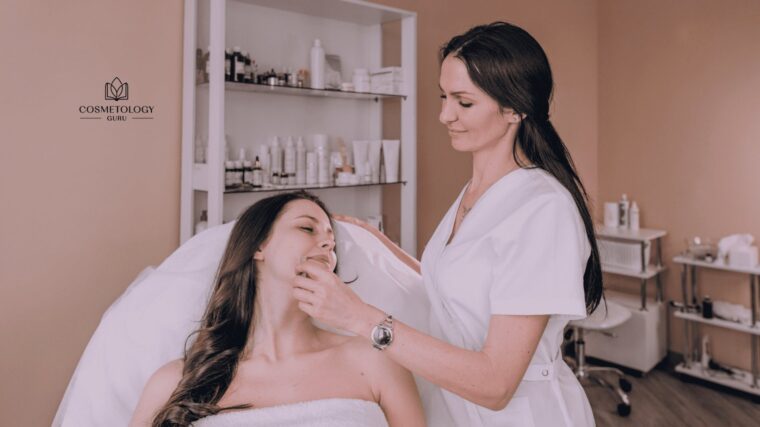Are you passionate about starting your career in the field of medical esthetics? Wondering about how to become a medical esthetician in the U.S.? Are you not sure of what medical estheticians do in a day? Worry not!
This article should help you gain a better understanding of medical estheticians, how to become a medical esthetician, and what medical estheticians do in a day.
What Do Medical Estheticians Do?
Medical estheticians work under the direction of medical professionals to provide skincare treatments to clients. They focus on esthetic procedures, dermatology, and plastic surgery using a variety of methods, such as lasers and chemical peels. Their daily tasks include:
- They provide treatment under the supervision of a qualified healthcare provider.
- They educate patients about their skin and provide them with suggestions for goods, or therapies if necessary.
- They work with clients to determine their skincare needs.
- They assist clients with cosmetic skin problems and scar concealment.
- They provide burns or surgical treatment as a specialty area of practice.
How to Become a Medical Esthetician?
Here are some steps to becoming a medical esthetician in the U.S.

EARN A HIGH SCHOOL DIPLOMA
Candidates who wish to enroll in medical esthetician programs must hold a high school diploma. You must either have a high school diploma or hold a GED to be able to apply and complete a medical esthetics program.
COMPLETE A MEDICAL ESTHETICIAN PROGRAM
The time taken to complete a medical esthetician program is determined by the degree or certificate. The minimum period of the certificate programs offered by cosmetology schools may be completed is in nine months. The maximum period of the medical esthetics program at a community college can last up to two years.
If you are looking for a career as a medical esthetician it’s best to choose a two-year community college. Before enrolling in a college students should ensure the program is accredited because this ensures an adequate level of education and also meets coursework. Several medical esthetician colleges are accredited by the following are some of the accreditations:
- National Accrediting Commission of Career Arts and Sciences (NACCAS)
- Accrediting Commission of Career Schools and Colleges (ACCSC)
- Accrediting Council for Continued Education & Training (ACCET)
- Council on Occupational Education (COE)
After enrolling in a medical esthetician school, students will learn the theoretical and practical aspects of skincare. The training program may include subjects like skin analysis, microdermabrasion techniques, depilation, skin chemistry and pathology, bacteriology, decontamination and infection control, skin hygiene, aromatherapy and esthetics, hair removal, makeup theory, acne treatment, and chemical peels.
OBTAIN STATE LICENSE
Once the medical esthetician training program is completed, students must take the exam. The exam will be administered by the state board of cosmetology. The exam consists of written and practical sessions. Students should pass the exam with a passing score of 75% or above.
Once a student passes the exam, they are licensed medical estheticians in the particular state and they are licensed to practice in that state. To maintain your license, you must renew it every year.
Career Opportunities
Once you have gained the medical esthetician license from the state, the next step is to understand the career options available for medical estheticians in the industry. Here’s a list of some of the job positions you can work in as a medical esthetician after procuring your state license.
- Skin Care Specialist
- Laser Technician
- Plastic Surgeon, or Assistant
- Clinical Instructor
- Medical Consultant
How Much Do Medical Estheticians Make?
According to the U.S. Bureau of Labour Statistics (BLS), the job outlook for a medical esthetician is projected to grow by 9% between the years 2022 to 2032. In 2022, the number of job openings for medical estheticians was 12,400 in the U.S. The hourly wage for a medical esthetician was $18.30 an hour and $38,060 per year in 2022. The lowest 10 percent earned less than $12.28, and the highest 10 percent earned more than $38.13.
There are some cities that pay better than others for medical estheticians. Following are some of the cities where the earning potential for a medical esthetician is high.
- Indianapolis, Indiana
- Atlanta, Georgia
- Los Angeles, California
- San Francisco, California
- Chicago, Illinois
- Nashville, Tennessee
- Detroit, Michigan
- Houston, Texas
- Minneapolis, Minnesota
- Fort Lauderdale, Florida
Wrapping Up
Medical esthetics is one of the fastest-growing industries in the beauty sector. If you have been wondering how to become a medical esthetician in the U.S., this article should have given you the answer to all your questions.
If you are someone who is passionate about becoming a medical esthetician or planning to take a cosmetology exam, make sure to try out our free practice test. Our free practice tests can help you effectively prepare for the cosmetology exam.
Frequently Asked Questions (FAQs)
1. WHAT SEPARATES A MEDICAL ESTHETICIAN FROM AN ESTHETICIAN?
Estheticians provide skin care and cosmetic services to clients at salons, spas, and other nonmedical settings. Whereas medical estheticians hold clinical or medical training and work with other medical professionals.
Estheticians may not have specialized training as medical estheticians so they focus on providing less advanced treatments for clients with minor skin issues. Unlike estheticians, medical estheticians provide can offer more advanced procedures, such as light-based procedures and laser treatments.
2. WHERE CAN YOU WORK AS A MEDICAL ESTHETICIAN?
When deciding between a career as an esthetician and a medical esthetician, it is important to understand the path option that offers. As an esthetician, you will be working about anywhere that provides skincare service. That includes spas, salons, and resorts. The following are some of the places you might work as a medical esthetician:
- Plastic surgery practices
- Medical clinics or hospitals
- Dermatology offices
- Luxury spas and resorts
- Medical spas
3. THE PROS OF BEING A MEDICAL ESTHETICIAN
The following are some of the pros of being a medical esthetician:
- They help improve skin for clients who deal with serious issues or burns.
- The growth potential is high.
- You can offer a customized blend of medical and esthetician services once you are dual-licensed.
Related Reads
6 Types Of Esthetician Specialist In The U.S.: A Comprehensive Guide


